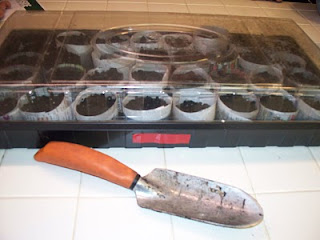Whether or not your local groundhog saw his shadow this morning, we know spring is coming: it is time to plant our pepper seeds!
As I mentioned in a previous post, I start my seeds on Groundhog Day because I'm in the lower part of zone 5 and I have a greenhouse that protects fragile plants during the sometimes up-and-down months of April and May. If that last sentence is all Greek to you, don't worry: If you reside somewhere that the traditional advice is to plant flowers outdoors on Mother's Day, start your peppers now. If tender plants go out later, delay a bit. If they go out earlier, then get moving!
I have made two changes to my seed-starting routine this year:
- I used to use the expandable peat pellets that fit neatly into the little plastic "greenhouse" tray. However, while the pellets are very convenient, I don't believe the claim that the fine mesh netting over the peat pellet is biodegradable; I've pulled those nets intact out of the ground at the end of a growing season, still clinging onto tomato roots. Instead, I am using the Burpee PotMaker http://www.burpee.com/product/seed+starting/potmaker-+1+potmaker.do, a cute little device that allows you to make seed starter pots from newspaper, which is certainly compostable. A little pricy, but I probably buy $10 worth of peat pellets each year, so this will pay for itself in two years.
- Consequently, I am now using potting soil to start the seeds. I'm convinced the little darlings will enjoy the nutrients in the potting soil more than they do the peat and will be healthier as a result. We will see.
Ultimately, I made my pots, filled them with potting soil, and put in a few pepper seeds. A few peppers will grow together as if they are a single plant, so five seeds in a pot isn't silly. We won't be doing this when we get to tomatoes and zucchini. Cover the seeds with a quarter to a half inch of soil, and cover the seeds with something that will hold in moisture. I am using a plastic "greenhouse," but others have a lot of success with boxes covered with plastic wrap.
Now for one of my secret techniques: While most garden supply stores will sell you heat mats to sit your seedlings on (and not a bad concept, because peppers, especially, like warm feet while they grow), I do the cheap version and sit mine on the counter over the dishwasher. The heat from the dishwasher makes the peppers warm enough to grow.
For those worried about grow lights and things of that nature, you won't really need to provide any artificial light until the seedlings sprout, so we will cover that in about two weeks, when those little green hairpins that are pepper plants start uncoiling out of the soil.
The Analysis
Fast: Hubby and I made the pots and planted the peppers in about an hour. We won't need to do much other than check the dampness of the soil for quite some time.
Cheap: The PotMaker set me back a bit this year ($19.95), but I think it will be a reasonable investment to reduce environmental impact. I promise myself every year that this fall I will bring in a container of humus from the compost pile to use for seed starting so I don't wind up paying $2.99 for 20 lbs. of dirt (who pays for dirt, for crying out loud?), and this year I renew that pledge. Someone yell at me in November to go out there and sift out some humus, OK?
Good: Things growing in February; very good indeed.





No comments :
Post a Comment